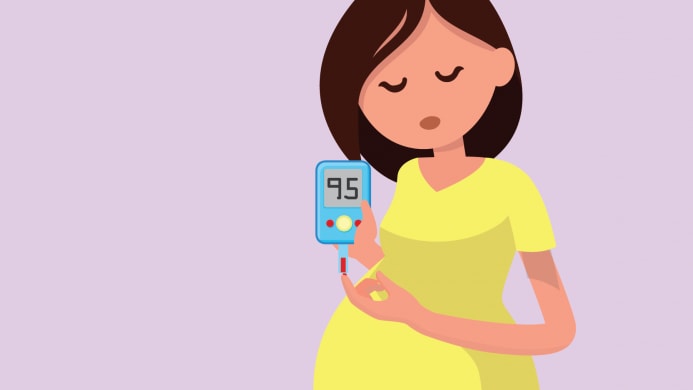At a glance
Managing diabetes throughout pregnancy helps to ensure a healthy pregnancy and healthy baby. For long-term health, continue to follow up with your health care provider after birth if you had diabetes while pregnant.

Types of diabetes
Diabetes is a disease that affects how the body turns food into energy. There are three main types of diabetes: type 1, type 2, and gestational diabetes.
With type 1 diabetes, the body doesn't produce insulin. Insulin is a hormone that helps blood sugar get into the cells to be used for energy.
With type 2 diabetes, blood glucose, also called blood sugar, is too high.
Gestational diabetes is a type of diabetes that first develops during pregnancy in women who don't already have diabetes.
Diabetes rates among pregnant women
In 2016, about 1% of US women who had a live birth had type 1 or type 2 diabetes.1 In 2021, about 8% of women who had a live birth developed gestational diabetes.2
Diabetes in pregnancy varies by race and ethnicity.3 Among women with a live birth, gestational diabetes is highest among Asian women. Preexisting diabetes is highest among American Indian and Alaska Native and Native Hawaiian and Pacific Islander women.1
Diabetes can affect pregnancy health
Diabetes during pregnancy can negatively affect the health of pregnant women and their babies. For pregnant women with type 1 or type 2 diabetes, high blood sugar around conception increases the risk of health problems. These include birth defects, stillbirth, and preterm birth. Additionally, among women with any type of diabetes, high blood sugar during pregnancy increases women's risk of having a cesarean delivery. It also increases babies' risk of being born too large and developing obesity or type 2 diabetes in the future.
Steps to manage diabetes before, during, and after pregnancy
Before pregnancy
It's important to see your doctor before getting pregnant if you have type 1 or type 2 diabetes. Discuss changes in blood sugar levels and how to adjust diabetes monitoring and medications. Also, check for and treat related health problems.
During pregnancy
Managing diabetes during your pregnancy can help you have a healthy pregnancy and a healthy baby. To manage your diabetes, see your doctor as recommended and monitor your blood sugar levels. Also, follow a healthy eating plan developed with your doctor or dietitian, be physically active, and take insulin, if directed. Learn more about how to have a healthy pregnancy with type 1, type 2, or gestational diabetes.
After pregnancy
Developing gestational diabetes makes you more likely to develop type 2 diabetes later in life. If you had gestational diabetes, get tested for diabetes 4 to 12 weeks after your baby is born. Even if your levels have returned to normal, get your blood sugar levels tested every 1 to 3 years.
If you have preexisting diabetes, monitor and discuss blood sugar level changes with a doctor after pregnancy. Adjust your diabetes management plan if needed and check for and treat related health problems.

Testing for gestational diabetes
It's important to be tested for gestational diabetes so you can begin treatment, if needed. This helps protect your health and your baby's health.
Gestational diabetes usually develops around the 24th week of pregnancy, so you'll likely be tested between 24 and 28 weeks.
If you're at higher risk for gestational diabetes, your doctor may test you earlier in your pregnancy. High blood sugar early in pregnancy may mean type 1 or 2 diabetes, not gestational.
Reducing risk of type 2 diabetes after gestational diabetes
To reduce the risk of type 2 diabetes following gestational diabetes, take the following steps.
If you are overweight, set a weight loss goal of 5% of your starting weight. Allow yourself time to recover and adjust to all the major life changes that come with having a new baby.
Make a nutrition plan for healthier eating.
Set a physical activity goal for healthier movement. Aim to engage in physical activity for at least 150 minutes per week. You can break up your activity into smaller chunks of time. Track your progress.
Use support to keep you going, including friends, family, or your health care provider.
For more tips on how to reduce your risk, visit CDC's diabetes web pages. If you are breastfeeding or recently gave birth, talk with your doctor about any weight or nutrition questions.
Women who had gestational diabetes or who develop prediabetes can also participate in a diabetes prevention lifestyle change program. Find a CDC-recognized lifestyle change class near you or join an online program.
- Deputy NP, Kim SY, Conrey EJ, Bullard KM. (2018). Prevalence and Changes in Preexisting Diabetes and Gestational Diabetes Among Women Who Had a Live Birth — United States, 2012–2016. MMWR Morb Mortal Wkly Rep 67:1201–1207.
- QuickStats: Percentage of Mothers with Gestational Diabetes, by Maternal Age — National Vital Statistics System, United States, 2016 and 2021. (2023) MMWR Morb Mortal Wkly Rep;72:16.
- Gregory EC, Ely DM. (2022) Trends and Characteristics in Gestational Diabetes: United States, 2016-2020. Natl Vital Stat Rep. 71(3):1-15.
